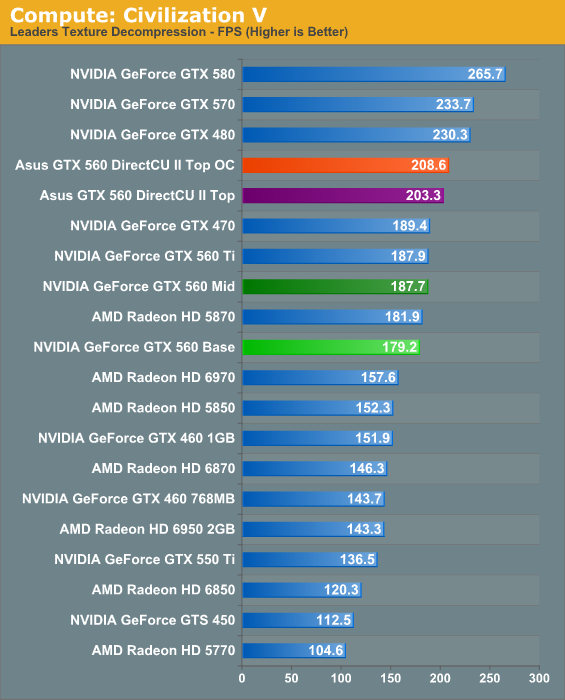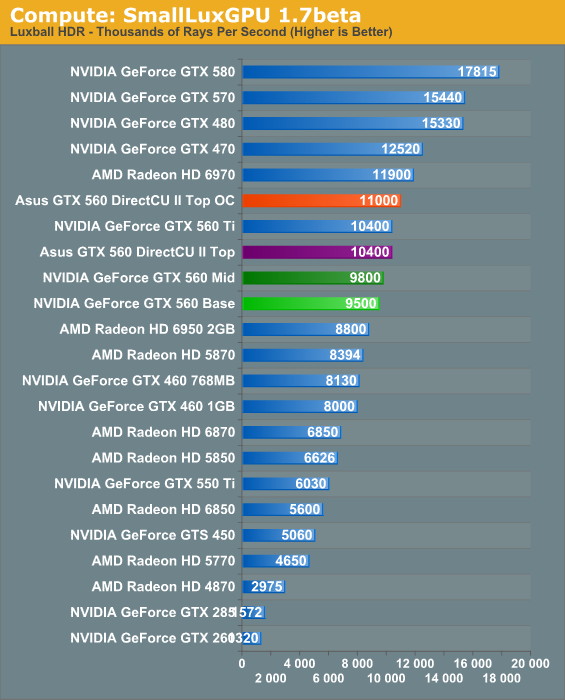NVIDIA's GeForce GTX 560: The Top To Bottom Factory Overclock
by Ryan Smith on May 17, 2011 9:00 AM ESTCompute Performance
Moving on from our look at gaming performance, we have our customary look at compute performance. Since compute performance is by definition shader bound, the GTX 560 is at a bit of a disadvantage here. Whereas the higher clocked ROPs would offset some of the GTX 560 Ti’s gaming lead, here the GTX 560 has nothing to stand on besides raw shader power.
Our first compute benchmark comes from Civilization V, which uses DirectCompute to decompress textures on the fly. Civ V includes a sub-benchmark that exclusively tests the speed of their texture decompression algorithm by repeatedly decompressing the textures required for one of the game’s leader scenes. Note that this is a DX11 DirectCompute benchmark.

This benchmark threw us for a bit of a loop, and we ended up running it several more times just to be sure. Under most circumstances the texture decompression test should be shader bound, but here it’s not – or at least not entirely. The GTX 560 Mid and GTX 560 Ti basically tie here, which is quite odd since the GTX 560 Ti has quite a shader advantage due to the 8th SM. As best as we can tell, either texture decompression doesn’t scale well with SMs, or it’s memory bandwidth bound at some point, with the latter case being the more likely of the two.
In any case as a result the GTX 560 Mid does quite well here, and the ASUS GTX 560 with its factory overclock shoots right past everything short of the 480/570/580. We’ll have to see if this weird outcome holds up in our other compute benchmark.
Our second compute benchmark of the day is SmallLuxGPU, the GPU ray tracing branch of the open source LuxRender renderer. While it’s still in beta, SmallLuxGPU recently hit a milestone by implementing a complete ray tracing engine in OpenCL, allowing them to fully offload the process to the GPU. It’s this ray tracing engine we’re testing.

Under SmallLuxGPU the GTX 560 behaves much more like we’d expect it to. The GTX 560 Mid does well, but it still falls behind the GTX 560 Ti as we’d expect. Keeping in mind that the theoretical difference should be around 10% in favor of the GTX 560 Ti however, the GTX 560 Mid still does a bit better than we were expecting, letting the GTX 560 take off with only a 6% lead. Compared to the GTX 460 however the difference is almost exactly what we’d expect it to be: the GTX 560 Mid is ahead by 23%.
Overall our compute results leave us a bit surprised: while extra shaders are normally extremely beneficial on compute benchmarks, that’s not entirely the case here. The GTX 560 series was never meant to be a compute powerhouse like the GTX 570/580, but if compute performance is a factor in your purchasing decision then it looks like you aren’t giving up much moving from a GTX 560 Ti to a GTX 560 Mid.










66 Comments
View All Comments
TheJian - Wednesday, May 18, 2011 - link
See my other posts. Nvidia finally got multithreaded rendering finished in their drivers (which should affect many games now, it's not GAME specific). Expect AMD to get theirs done soon. This isn't Civ5 or Anandtech favoring NV, it's just the beat AMD to the punch in getting drivers finished. If AMD takes another year to get their drivers done, I'm glad they report this. I hope AMD gets them done soon, or the next set of cards that get benched might show quite a few games with AMD bunched at the bottom of the list.NOTE: this is a DRIVER issue, not game issue. Both sides have been working on getting this in their drivers for a while. It's about time :) The game had this in it all the time (many other too, get ready for speedups if you own NV and running 2.75 drivers (whatever is latest from NV). Unfortunately my 5850 has to wait for AMD. :(
JarredWalton - Tuesday, May 24, 2011 - link
You know what the best part is about Civ5? AMD is the one that gave out copies of the game to reviewers. Yup -- that and F1 2010.L. - Thursday, May 19, 2011 - link
Errr/ metacritic lol ?We're talking benchmarking here, not playing the game.
AMD being poor is their problem, we shouldn't care ;)
Besides, the way people rate on metacritic or any critic source for anything is at most a relative indicator of how people who take the time to vote feel about stuff... doesn't help that much does it ?
Crysis 2 is NOT in the same series as Crysis 1. If you don't know why, read some more about it.
L. - Thursday, May 19, 2011 - link
Two words for you mate, Bench and MarkThe purpose of benchmarking is to get a relative idea of the performance of a component, not to test every little game out there, because of that reviewers attempt to have a most relevant panel of games/ benchmarks to test the gfx cards.
Crysis 2 is not (yet) a relevant benchmark. Maybe when they're done writing the engine for PC's it will be, but now it's just a worthless console port.
IF you think they're lazy, just post a list of the games you would use to benchmark and ask people how useful they find those.
Spoelie - Wednesday, May 18, 2011 - link
Metro 2033 is a game that requires the force scaling flag I believe. It ignores the scaling settings in AMD's drivers on windows 7 at least..Coloring is wrong on the Civ5 graph (last one)
GeorgeH - Wednesday, May 18, 2011 - link
Taken out of the noise of the other comment stream:"RE: Time to change the tests by Ryan Smith on Tuesday, May 17, 2011
The test suite is due for a refresh, and will either be updated at the end of this month or next month once we build our new SNB testbed."
Weren't you waiting for SNB-E? Isn't that a Q4 release? Or by "SNB" do you mean "Bulldozer" and know something that we don't?
You've got me all curious and maybe excited and more curious and now I-don't-know-what-to-think.